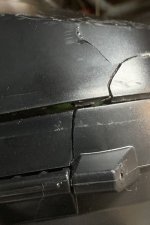Your cases are likely ABS, good news is they are easy to fix. I’ve done lots of fairing and box repairs - I should YouTube one. Here’s a step by step repair.
1. Drill a 1/8” hole at the end of each crack. This will stop the crack from running.
2. clean the inside surface and crack thoroughly with acetone.
3. make a repair slurry by dissolving scrap abs in acetone. Use a pint mason jar, 1/4 filled with acetone then add abs. You can use abs drain pipe, or for colour use LEGO blocks in as close to the colour as possible. It takes 24 hours to make the slurry, it should be a viscosity between liquid honey and peanut butter.
4. Do each crack separately, the material sets up fast. Spread the crack slightly with a flat blade screw driver. Using a cotton ball, dab acetone into the crack to prime it for repair, also wipe the backside about 1” each side. Repeat 3 times, make sure the acetone hits both mating surfaces. Be generous and fast.
5. using a popsicle stick, press the slurry into the crack from the back side, a small even bead should squish thru to the good side. Remove the screwdriver that held the crack open. You might have to clamp the crack if it doesn’t align itself. You have 2 minutes to complete this step.
6. Using your popsicle stick, feather a patch on the back side 1” wide and at least 1/16” thick.
6b. If the crack is really big, make a back patch from 1/8” abs (Amazon). Cut the patch to size, about 1” wide, then soak the patch for 30 min in acetone to soften it, then press over the crack.
7. A small bead of abs should be on the finished side, use a small exacting to trim it off before it hardens.
Repeat for the next crack.
Voila! Done
 The type of black plastic used doesn’t seem to repair with the types of epoxies [LePage], super glues [Krazy and Gorilla brands] and polyurethane glues [LePage] I’ve tried/tested. Even Permatex Plastic Welder doesn’t seem to have a great bond.
The type of black plastic used doesn’t seem to repair with the types of epoxies [LePage], super glues [Krazy and Gorilla brands] and polyurethane glues [LePage] I’ve tried/tested. Even Permatex Plastic Welder doesn’t seem to have a great bond.
